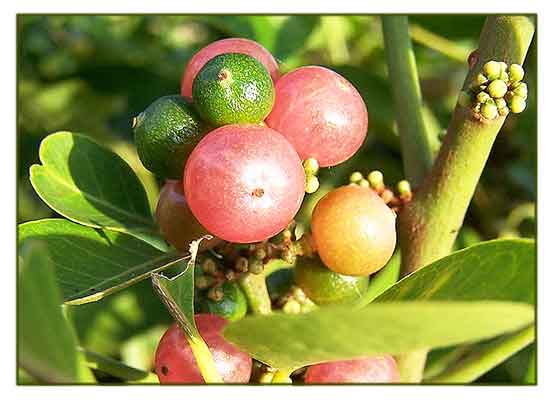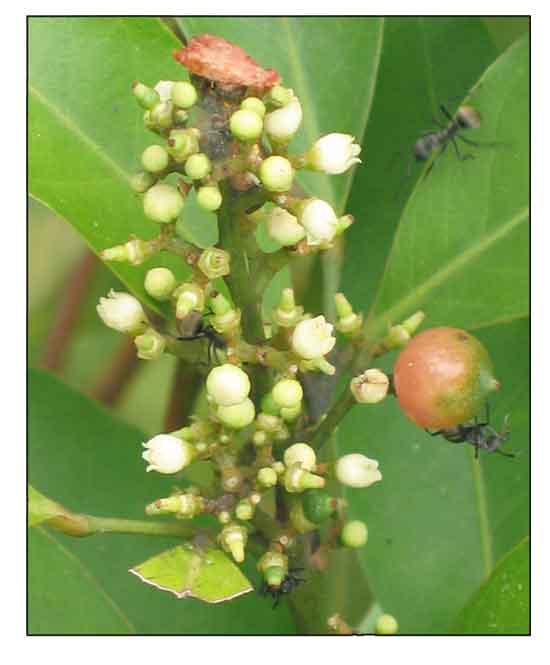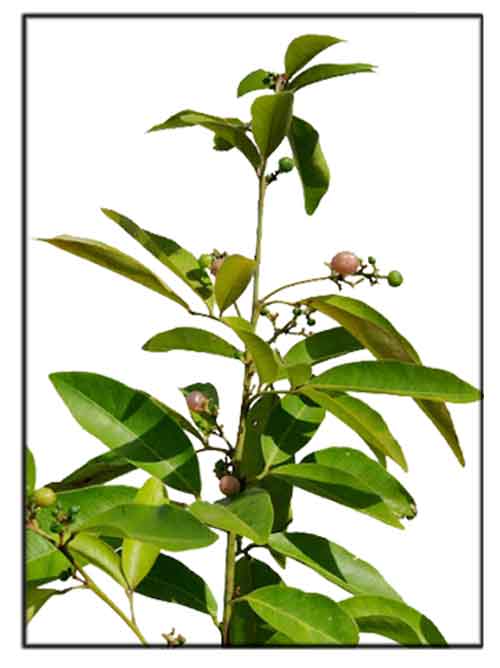
Family • Rutaceae
Orange berry
Glycosmis parviflora (Sims) Little
CHINESE GLYCOSMIS / FLOWER AXISTREE
Xiao hua shan xiao ju
| Scientific names | Common names |
| Amyris axilliflora Griseb. | Chinese glycosmis (Engl.) |
| Glycosmis americana Sagot ex Oliv. | Flower axistree (Engl.) |
| Glycosmis citrifolia Lindl. | Glycosmis parviflora (Engl.) |
| Glycosmis heterophylla A.Rich. | Hill orange (Engl.) |
| Glycosmis obtusa Miq. | Orange berry (Engl.) |
| Glycosmis parviflora (Sims.) Little | Parviflora glycosmis (Engl.) |
| Glycosmis parviflora var. obtusa (Miq.) B.C.Stone | Parviflora orangeberry (Engl.) |
| Glycosmis pentaphylla var. citrifolia (Lindl.) Bakh.f. | Philippine box orange (Engl.) |
| Limonia citrifolia Willd. | |
| Limonia parviflora Sims. | |
| Murraya cerasiformis Blanco | |
| Glycosmis parviflora (Sims) Little is an accepted species. KEW: Plants of the World Online | |
| Other vernacular names |
| CHINESE: Xiao hua shan xiao ju. |
| CUBA: Limoncillo, Limoncito de China, Naranjita de cristal. |
| PORTUGUESE: Glicosmis. |
| VIETNAMESE: Chanh rung, Cin ruou la chanh, Com ruou hoa nho. |
Botany Distribution  Constituents Constituents- Ethyl acetate extract showed highest TPC (147.47 mg GAE/g extract) and n-hexane extract showed highest TFC (132.71 QE/g extract). (see study below) (3) - GC-MS study of aerial parts yielded a total of 37 components comprising 98.7% of essential oil. Major components were (Z)- caryophyllene (20.6 %), methyl isoeugenol (11.1 %), (Z)-β-ocimene (8.9 %), α-cubebene (6.4 %), nerolidol (5.4 %), aromandendrene (4.9 %) and γ-pyronene (4.7 %). (see study below) (4) - Study of aerial parts yielded three triterpenes, a sesquiterpene, and a flavonoid C-glycoside. The terpenes were friedelin, arborinol, isoarborinol, and spathulenol, and the glycosides was vitexin. (see study below) (6) - Bioassay-guided study of stems isolated eleven compounds, including a novel alkaloids, eight known alkaloids, one flavonoid, and one saponin steroid. (see study below) (8)
Availability |
December 2023
![]()
 |
| PHOTOS / ILLUSTRATIONS |
| IMAGE SOURCE: Glycosmis parviflora / 阿橋 HQ / CC BY-SA 2.0 / click on image or link to go to source page / Wikipedia |
OTHER IMAGE SOURCE: Glycosmis parviflora - Ripening fruits / Ray cul / Creative Commons 2 Share Adapt / image modified / click on image or link to go to source page / Useful Tropical Plants |
| OTHER IMAGE SOURCE: Glycosmis parviflora - Young potted plant flowering and fruiting / Rufino Osoria / Non commercial use / Image modified / click on image or link to go to source page / Rufino Osorio |
Additional
Sources and Suggested Readings |
• |
DOI: It is not uncommon for links on studies/sources to change. Copying and pasting the information on the search window or using the DOI (if available) will often redirect to the new link page. (Citing and Using a (DOI) Digital Object Identifier) |
| List of Understudied Philippine Medicinal Plants |
| New plant names needed The compilation now numbers over 1,300 medicinal plants. While I believe there are hundreds more that can be added to the collection, they are becoming more difficult to find. If you have a plant to suggest for inclusion, native or introduced, please email the info: scientific name (most helpful), local plant name (if known), any known folkloric medicinal use, and, if possible, a photo. Your help will be greatly appreciated. |
• |
 |



